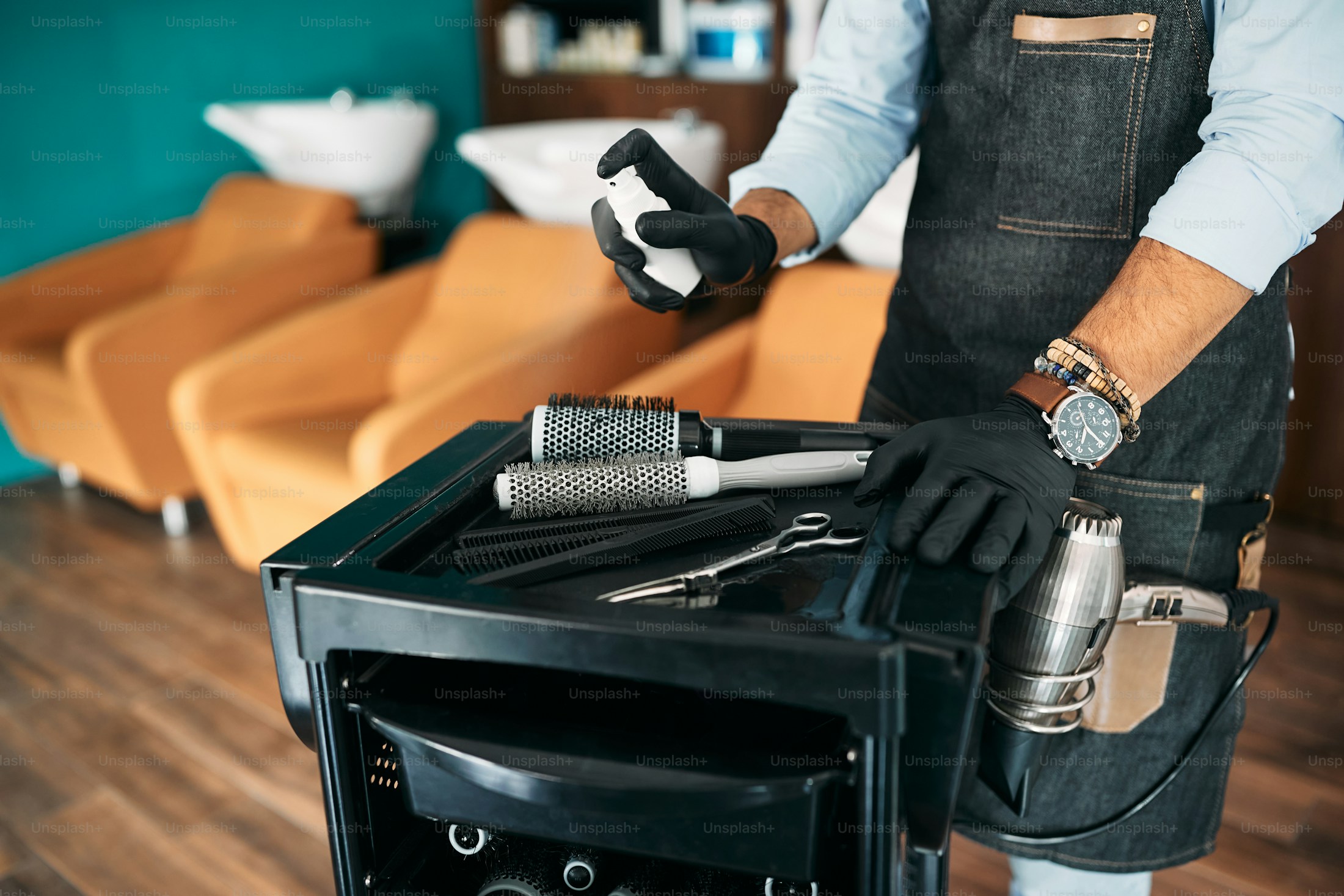Look, nothing kills a premium edge faster than colour residue and a quick wipe on the nearest towel. Australian hygiene standards are tightening, clients notice streaky blades, and your scissors deserve better. Here is the 90-second between-client routine and the five-minute close-down ritual that keeps your shears sharp, safe, and inspection ready.

Photo: Getty Images via Unsplash
Between every client (90 seconds)
- Remove loose hair with a dry microfibre cloth or disposable towel. Avoid brushing hair into the pivot.
- Spray both blades with 70% isopropyl alcohol or TGA-approved hospital grade disinfectant. No dunking baths—spray or wipe only.
- Respect contact time. Leave the blades open on your trolley for the full label time (usually 60 seconds).
- Dry thoroughly using a lint-free cloth, paying attention to the screw area. Moisture sitting in the pivot breeds rust.
Assessment tip: Keep a small sand timer or phone timer running. Compliance fails happen when you shortchange the contact time.
Set up a ready-to-go hygiene caddy
- Travel-size 70% iso spray + backup refill
- Lint-free wipes in a sealed container
- Pivot oil with needle applicator
- Micro brush or wooden toothpicks for colour flakes
- Maintenance log (pull the printable template from ScissorPedia)
End-of-day deep clean (5 minutes tops)
- Warm soapy wipe: Mix a bowl of warm water with a drop of mild detergent. Dip a cloth, wring it out, and wipe the blades (avoid soaking the pivot).
- Rinse cloth, wipe again: Remove any soap residue with a damp, clean cloth.
- Detail the pivot: Use a soft brush or wooden toothpick to dislodge colour flakes and trapped hair.
- Disinfect again: Spray with alcohol or disinfectant and let it air dry on a clean towel.
- Oil the hinge: Open to 90 degrees, pop a single drop of scissor oil on the pivot, open/close ten times, then wipe excess. This keeps tension true and protects the bearings.
Weekly reset checklist
- Perform the drop test: open blades to 90 degrees, raise the thumb handle, let it fall. Closing two thirds = perfect tension.
- Inspect edges under bright light. Any shiny flat spots or nicks need pro attention.
- Wipe handles and tangs—product build-up irritates skin and harbours bacteria.
- Log knocks or drops in your maintenance notebook for the sharpener.
- Review the ScissorPedia cleaning guide for any updated product recalls or TGA advisories.
Storage that actually protects your edge
- After hours: Rest scissors in a padded roll or upright magnetic stand. Loose drawers are edge killers.
- Mobile work: Use blade guards and a hard case. Keep silica gel sachets in the bag to absorb moisture during steamy summer days.
- Long breaks: Loosen tension a quarter turn if the scissors will sit more than a week to relieve spring pressure.
- Backup kit: Keep a secondary pair in the roll—if your primary blades are drying post-clean you still have a compliant option for emergency walk-ins.
Disinfectant dos and don’ts
| Do | Don’t |
|---|---|
| Use 70% iso or hospital-grade sprays and wipes | Soak scissors in Barbicide or bleach baths |
| Follow contact times and wipe dry | Assume “air dry” means leave them wet overnight |
| Clean combs and clips separately | Mix brushes and scissors in the same disinfectant tub |
| Wear gloves if your skin reacts to chemicals | Use kitchen oils or WD-40 as a substitute for scissor oil |
Product cheat sheet (2025 salon favourites)
| Use case | What stylists rate | Why |
|---|---|---|
| Daily disinfect | BEUTY.GIENE 70% iso spray | Fast contact time, TGA-listed |
| Colour build-up | Scrummi eco-friendly lint-free wipes | No fibres trapped in pivots |
| Coastal corrosion control | Marine-grade scissor oil (JapanShears listing) | Displaces salt moisture |
| Deep clean weekly | Neutral pH detergent (per ScissorPedia mix ratio) | Gentle on ATS314 and VG10 |
Caring for combs and brushes (bonus refresher)
- Remove hair with a tail comb.
- Wash in warm soapy water, rinse, then submerge in disinfectant for the full label time (typically 10 minutes).
- Rinse, shake dry, and store upright or on a clean towel to air dry completely.
Troubleshooting common hygiene hiccups
- Cloudy residue on blades: Your disinfectant dries tacky. Wipe with alcohol and switch brands or dilute per instructions.
- Rust spots near the pivot: Moisture sat too long. Step up your drying game and oil nightly.
- Squeaky hinge even after oiling: Hair is trapped under the screw. Unscrew carefully, clean, and re-oil—or book a tech if you are unsure.
- Clients questioning your routine: Talk them through it. It builds trust and shows you respect their safety.
- Sharpeners reporting gunk build-up: Snap photos of your routine, compare against the ScissorPedia cleaning standard, and adjust contact times or detergents accordingly.
Ready to tighten your hygiene workflow?
Snap a pic of your current set-up, note the products you use, and send it through. We will help you tweak the routine so your scissors stay sharp, compliant, and ready for surprise inspections. Ask for a hygiene audit.
Photo: Getty Images via Unsplash